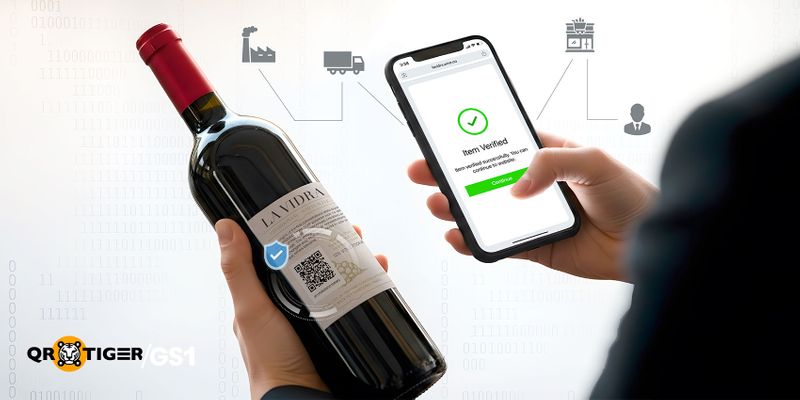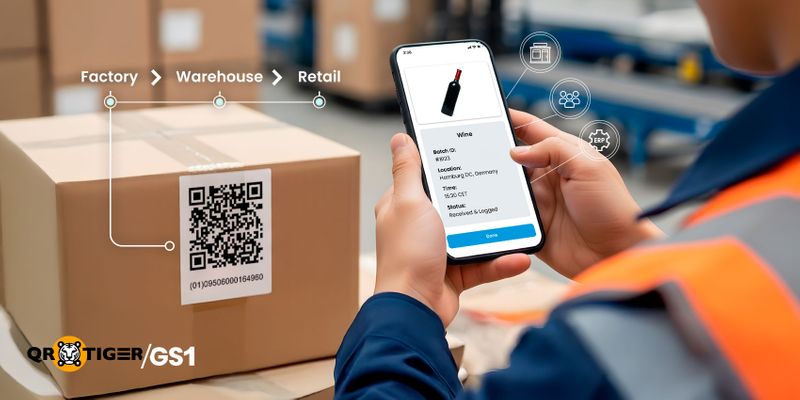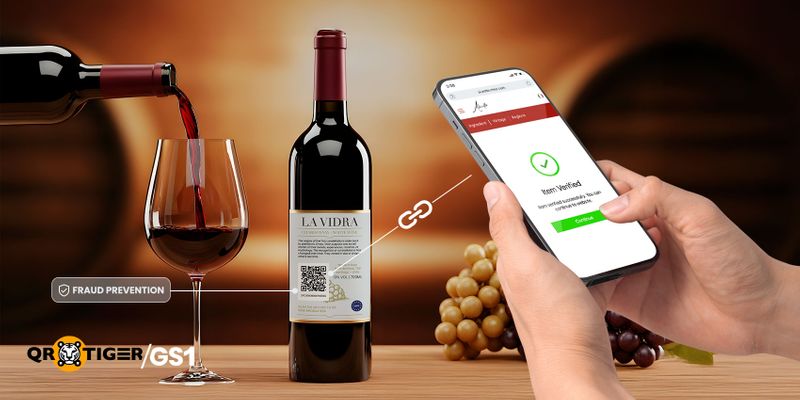What does GS1 QR code security mean?

In modern supply chains, ensuring product authenticity, traceability, and data integrity is more challenging than ever. Consumers expect instant, reliable product information, while businesses must meet stricter regulations and enable updated data sharing.
Static barcodes can’t keep up with these demands. This drives the need for secure, dynamic labeling solutions that connect physical products to digital systems and protect sensitive product data.
The article will explore how GS1 QR code security works, what it can and can't do, and its role across supply chain applications.
Table of Contents
- What QR codes powered by GS1 can enable when implemented properly?
- What QR codes powered by GS1 do not offer by default?
- Why the linked web page matters more than the GS1 QR code security
- Best Practices for Safe GS1 QR Code Scanning
- Use Cases and Security Best Practices
- The true meaning of GS1 QR code security
- Frequently Asked Questions
- Are Next Generation Barcodes secure?
- Can Next Generation Barcodes be read with smartphones?
- How can I verify the security of a GS1 QR code?
- Can GS1 QR code security help prevent product recalls?
- Is a QR code powered by GS1 inherently secure?
- Can scanning a QR code powered by GS1 expose users to risks?
- What’s the role of the brand domain in GS1 QR code security?
What QR codes powered by GS1 can enable when implemented properly?
When implemented following the best practices, a GS1 Digital Link QR code can improve product security, strengthen supply chain integrity, and build consumer trust.
QR codes powered by GS1, built on the Digital Link standard, are becoming the global solution to labeling challenges. These next-generation 2D barcodes can carry GTINs, expiry dates, batch numbers, and links to verified digital content—all in one scan.
Their adoption is being driven by the GS1 Sunrise 2027 initiative. Several supply chain systems are expected to be upgraded to adopt 2D barcodes over the upcoming 5–7 years. So, choosing to upgrade will ensure easy compatibility with the latest workflows.
By linking to brand-owned domains and secure resolvers, they boost authenticity, prevent tampering, and support regulations like the EU Digital Product Passport, making them key to secure, future-ready product labeling.
The GS1’s Sunrise 2027 initiative is already underway in 48 countries, covering 88% of global GDP. Acting early will benefit businesses from improved traceability, efficiency, and digital engagement well before the 2027 deadline.
Benefits of QR codes powered by GS1 are only realized when supported by robust digital infrastructure, secure data governance, and collaboration across all stakeholders.
Let’s understand what they enable and the key limitations to tackle.
Product Security
QR codes powered by GS1 enable product authentication by linking unique identifiers like Global Trade Item Numbers (GTINs), serial numbers, and batch codes. This allows them to link to secure databases or brand-owned portals. When set up properly, retailers, consumers, and regulators verify authenticity.
Use Case: A consumer scans a QR code powered by GS1 and lands on a brand-hosted page confirms the product’s authenticity, shows manufacturing details, and highlights any recall alerts.
Industries with high counterfeit risk—such as pharmaceuticals and luxury goods benefit significantly from using GS1 QR code for authenticating products and counterfeit prevention, which serves as a powerful tool to ensure supply chain integrity.
By enabling serialization and supporting robust verification workflows, these codes help systems detect unauthorized duplication or product diversion.
Without this setup, the QR code is just a static identifier—easily copied and useless for security purposes.
Limitation: Authentication only works if the brand or a trusted third party maintains a secure, regularly updated verification platform. This system should validate the unique identifier dynamically, show relevant data like last scan location and expiry date, and detect issues (like invalid serials or duplicate scans).
Supply chain security

QR codes powered by GS1 enhance supply chain visibility by allowing the sharing of serialized product data across the supply chain industry. When scanned at different checkpoints, they can log critical tracking events such as manufacturing, warehousing, shipping, and retail delivery.
A traditional barcode can encode only up to 85 characters, whereas a QR code powered by GS1 can encode up to 4,269 alphanumeric characters. This capacity allows them to incorporate product information into a Digital Link URI—a superset of identifiers that transforms barcodes into web links.
Use Case: A logistics provider scans a QR code to log a product’s arrival at a distribution center. The scan ensures dynamic traceability by updating a shared ledger or ERP system.
Using a GS1 QR code for supply chain distribution enables cold chain compliance, identifies unauthorized distribution, and simplifies recalls.
Limitation: The GS1 QR code security in the supply chain depends on data sharing and interoperability. The chain of custody breaks down if stakeholders do not:
- Scan and log events consistently
- QR code does not follow Digital Link standards
- Share data via a resolver or traceability platform
Note that the QR code alone can’t ensure traceability without system-wide adoption and integration.
Consumer-Facing Trust Signals
GS1 QR codes link to brand-managed product info. The information can be sustainability data, usage instructions, origin details, and regulatory disclosures.
Use Case: A shopper scans a QR code powered by GS1 on a food package and lands on a product page. This page can reveal sourcing details, allergen info, and recycling instructions based on that particular location.
Linking to a verified brand domain with detailed product information enhances traceability and consumer trust, supporting transparency goals aligned with the EU Digital Product Passport and Extended Producer and Responsibility (EPR) frameworks.
Limitation: The trust signal is effective only if:
- The landing page is regularly updated, mobile-optimized, and accurate
- It is clearly branded, not a generic redirect
- The content is accessible and localized, including for people with disabilities.
Note that if the QR code redirects to an outdated or generic page or a third-party website, then consumers lose trust in the brand, and thus, consumer engagement drops.
What QR codes powered by GS1 do not offer by default?
QR codes powered by GS1 are not inherently more secure than standard QR codes. Their strength lies not in the code itself, but in the ecosystem, i.e., the infrastructure, connected digital services, and data governance.
Let’s understand what these codes don’t offer by default.
No native encryption or built-in privacy features: These codes don’t have built-in encryption or privacy mechanisms. The encoded data is usually stored as plain text within the Digital Link URI.
This makes the data readable by any standard QR code scanner, ensuring interoperability but also exposing the data to unauthorized access if not secured properly.
QR codes powered by GS1 encode structured identifiers and URLs, but they do not inherently provide data protection or privacy safeguards. Once scanned, the code reveals a URL that can be accessed by any device—the QR code itself does not restrict access or manage user data.
Sensitive functions such as data validation, user authentication, personalized content delivery, and privacy controls must be implemented at the landing page or resolver level. Without these backend protections, the QR code acts only as a passive link—not a security layer.
Lacks watermarking and tamper evidence: Watermarking, tamper-evident seals, or holograms are not part of the QR code format itself. These types of QR code can encode serial numbers or digital signatures to support anti-counterfeiting, but they can’t stop physical duplication.
Without additional digital or physical safeguards in place, malicious actors can duplicate the QR code and apply it to a counterfeit product.
According to GS1’s best practices, the QR code’s security relies on three key elements. These are the brand’s domain, the integrity of the resolver, and the quality of the digital experience it links to.
The QR code can’t protect data integrity or guarantee authenticity in the absence of a robust backend and a secure, brand-owned domain.
Why the linked web page matters more than the GS1 QR code security
The QR code provides a standardized way to encode product identifiers and link to digital content. However, they are fundamentally gateways. The security, privacy, and reliability of the experience depend on the destination web page—especially the resolver domain and the implemented infrastructure.
The role of the resolver domain in trust and security: A resolver is a web service that interprets the Digital Link URL embedded in a QR code and lands the user on the appropriate online resource (such as a product information page, regulatory disclosure, or recall notice).
When hosted on a brand-owned domain, the resolver plays a key role in establishing trust and authenticity. The resolvers help ensure:
- The QR code redirects to brand-authorized content, not tricked or malicious pages.
- The destination can be updated dynamically without altering the printed code.
- The platform enables smart redirection, denoting tailored information based on who scans it. For example, it shows different content for retailers and consumers.
If the resolver runs on an untrusted or third-party domain or isn’t properly maintained, the GS1 QR code security is likely compromised.
Data security depends on the destination: The GS1-compliant QR code itself doesn’t enforce data privacy.
They only encode a URL. When scanned, the linked web page or API endpoint stays responsible for:
- Handling personal data (for example, device info, location, user behavior)
- Complying with data protection laws such as:
- GDPR (General Data Protection Regulation) in the EU that mandates consent, transparency, and data minimization for any personal data collected.
-CCPA (California Consumer Privacy Act) that grants consumers rights over their data, including deletion, access, and opt-out of sale.
If the destination page collects user data via forms, cookies, or analytics, it should disclose this and get consent where required.
The QR code should link to a brand-owned, privacy-compliant landing page that is mobile-optimized, HTTPS-secured, and transparent for data usage.
In the absence of these protections, the QR code is non-GS1 compliant and may be used in phishing attacks or privacy violations.
Note that QR codes are only as secure as the digital environment they connect to. To fully unlock the potential of QR code security, brands should invest in secure, standards-compliant resolver infrastructure and ensure landing pages are privacy-conscious and compliant.
Best Practices for Safe GS1 QR Code Scanning
To avoid scanning malicious or fake QR codes, follow these safety tips:
- Always check the URL: It should start with “https://”, not “http://”.
Avoid scanning codes that lead to shortened links like bit.ly or tinyurl, especially if you're unsure of the source. Turn off auto-redirect in your QR scanner app: This lets you see the URL first before it opens automatically. It gives you a chance to check if the link looks suspicious.
- Verify that the GTIN in the URL matches the product: Check if the GTIN (the product’s barcode number) shown in the link matches what’s printed on the product.
A mismatch could mean the QR code was swapped or faked. - Inspect the QR code for signs of tampering: Be extra careful with stickers. If the QR label looks misaligned, wrinkled, or different from the packaging, it might have been replaced.
- Keep your phone’s antivirus or security software updated: Updated security tools can help block harmful pages.
- Scan products from trusted, legitimate stores: QR codes from unknown or unverified sellers are more likely to be fake or unsafe. Stick to retailers you trust.
Use Cases and Security Best Practices
When implemented with the appropriate infrastructure and governance, QR codes powered by GS1 provide great benefits across industries. Let’s go through different use cases, each highlighting how these codes enhance security, traceability, and trust.
Wine Authentication

In the wine industry, QR codes powered by GS1 are used to meet EU Regulation 2021/2117, which mandates digital disclosure of ingredients and nutritional values. Apart from compliance, they also assist in authenticity verification and brand storytelling. Let’s understand how it works with an example.
Producers like Vinca Wines use QR codes standardized by Digital Link URI to direct consumers to e-labels that differ by region. For example, EU users would see regulatory content, whereas non-EU users may access promotional material or provenance stories.
QR codes powered by GS1 help avoid fraud by linking each bottle to a unique, brand-regulated digital identity.
Best practice: Brands can implement IP-based filtering and resolver infrastructure to provide localized content while maintaining compliance. Avoiding fraud and maintaining trust requires that all QR codes consistently link to a secure, brand-owned domain (for example, id.brand.com).
Consumer Engagement
GS1-compliant QR codes are also transforming the way brands interact with consumers. When properly set up, they can provide personalization, transparency, and post-sale services. Let’s understand how it works.
A consumer scans the QR code on a product and is directed to a landing page that may contain product sustainability credentials, instructions, allergen info, or details of loyalty programs.
Since the QR code links to a GS1-conformant resolver, brands can make sure their consumers are always directed to reliable, up-to-date content, decreasing the risk of phishing or false information.
By using the GS1 QR code generator, businesses can create QR codes for improved product tracking and consumer engagement. 
The true meaning of GS1 QR code security
The GS1 QR code security isn’t built into the code itself; it’s achieved through careful implementation. The code serves as a gateway, but the protection is ensured from secure, brand-owned domains, compliance with privacy laws like GDPR and CCPA, and robust backend systems that validate data and detect threats.
These codes focus on securing product and supply chain information, not personal data. So, organizations should implement layered security models, combining GS1 standards with robust infrastructure and responsible data governance to guarantee trust and security.
Frequently Asked Questions
Are Next Generation Barcodes secure?
Yes, next-gen barcodes are implemented with enhanced security and traceability features that support global standards. They enable structured data encoding and link to brand-managed digital records, enabling verification of product authenticity and supporting safe data sharing across supply chains.
Being compatible with smartphone cameras and the capability to integrate technologies like AI and blockchain makes them suitable for counterfeit prevention, recall management, and regulatory compliance.
Can Next Generation Barcodes be read with smartphones?
Yes, next-gen barcodes such as GS1 DataMatrix and QR codes powered by GS1 can be read using smartphones having standard camera apps or barcode scanning apps. These barcodes are smartphone-compatible, allowing businesses and consumers to instantly access product-specific information such as origin, recall notices, and expiry date with a single scan.
This broad accessibility supports broader adoption across industries like retail, logistics, and healthcare, and simultaneously enhances user engagement and transparency.
How can I verify the security of a GS1 QR code?
Verifying the security of a GS1-compliant QR code is possible by ensuring that it adheres to GS1 standards and is linked to reliable data sources. Using Verified by GS1 service allows users to validate the authenticity of GS1 identifiers such as GLNs, GTINs, and company information.
Can GS1 QR code security help prevent product recalls?
Yes, it can help avoid product recalls by facilitating real-time data access and precise traceability. QR codes powered by GS1 can encode critical product data such as serial numbers, batch numbers, and expiry dates.
This allows retailers and manufacturers to quickly identify and isolate affected items during a recall, thus reducing risk and disruption.
Is a QR code powered by GS1 inherently secure?
No, the QR code itself is just a carrier of a URL or data. It doesn’t have built-in security features like encryption or access control. Its security depends on how the linked content is managed.
Can scanning a QR code powered by GS1 expose users to risks?
If the QR code leads to an untrusted or spoofed site, then it can expose users to risk. Users must scan codes only from reliable sources and refrain from unknown or suspicious ones.
What’s the role of the brand domain in GS1 QR code security?
A brand-controlled domain (for example, id.brand.com) adds a layer of trust. It guarantees users that the content is legitimate and decreases the risk of phishing or redirection to malicious sites.



